Cat Behavior



Cat Behavior
More Posts from Risingstarling and Others








Sasuke: KumaQui ( KumaQi熊祁)
Itachi: coser天狼
Btw Sasuke (KumaQui) was like: Itachi is beautiful ~ , and Itachi replied:”Baby brother, people are looking at your chest and your face…” ( 弟弟,他们眼里只要是在看你的胸和脸啊!!)
|太多的羁绊只会让自己迷惘,强烈的想法和珍惜的思念,只会让自己变弱 …. (这二柱子全程一脸看智障的看着鼬好嘛!!)||
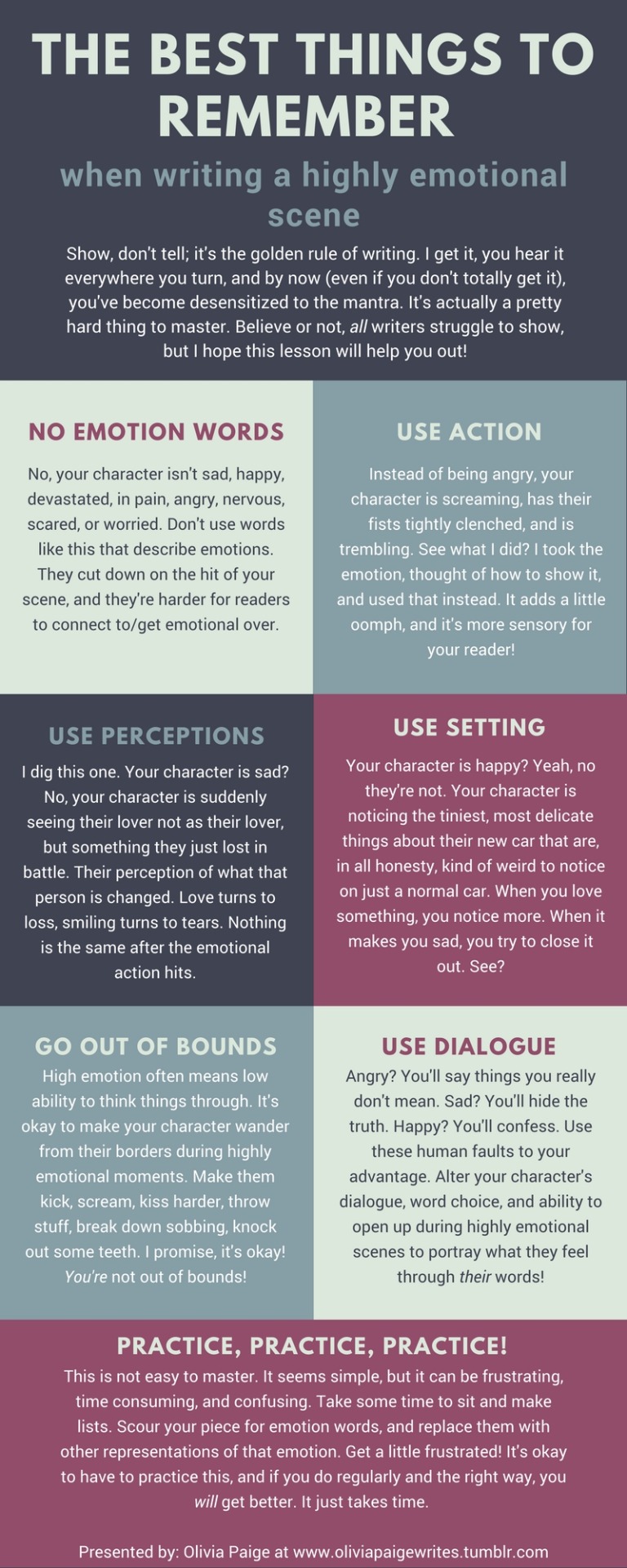
THIS IS AN IMPORTANT ONE! Don’t ignore this in your writing!
3 Study Methods You Should Use More Often
This was originally for an article writing assignment, but I thought “why not write something I can also post on my blog?” so here are three study methods that I haven’t seen a lot of in the studyblr community but are definitely worth mentioning.
The Leitner System
Flash cards have remained one of the most popular ways to study. Some people use them to memorize vocabulary, remember answers to specific questions, or even associate dates with events. Although the use of flash cards is convenient, their effectiveness has been reduced due to most people’s habits of prioritizing each card equally and therefore spending too much time memorizing the information on them.
The Leitner System, created by a German popularizer of science named Sebastian Leitner, is a more efficient method of studying that implements the concept of spaced repetition. All the cards start off in one pile. You would first scan through these cards, then test yourself. Each card you answer correctly goes to a second pile, while those you answer incorrectly should be revised then placed at the bottom of the pile. When you review the cards in the second pile and get them correct, they will be promoted to a third pile. An incorrect card will always get demoted to the first pile, even if they had previously been promoted to the last pile.
The reason why this method is so effective is that you end up reviewing the first pile of cards more frequently—the cards you don’t know very well. Some people choose to review their Stack 1 cards every day, Stack 2 cards every other day, Stack 3 cards once every three days, and so on.
Once all your cards have been promoted to the highest box, study them thoroughly and then start over. The continuous revision trains your speed so that you may reach fluency, which allows you to recall the information faster.

Timed Memorization
The name tells it all: you memorize a certain text within a time limit, normally around five to ten minutes depending on your fluency and memorization abilities. When the timer starts, you begin memorizing. When time is up, you flip to the next page, even if you haven’t finished the previous page yet. Continue until you’ve gone through all your material.
Timed memorization helps you to discipline yourself because your brain thinks that there’s no time for messing around; you have to do this here and now. Make sure to repeat the things you missed and revise everything frequently. This method is actually one of the most effective for cramming as it gives a better coverage than if you spend a whole half hour memorizing one subtopic.
The Memory Palace or Mind Palace
Sound familiar? In BBC’s Sherlock, the ‘highly functioning sociopath’ uses this method to remember vital information and facts. A mind palace is a systematic arrangement of information, each detail corresponding to a specific object in a familiar place. To ensure that you really remember everything, the objects have to appear shocking and conspicuous.
Here’s an example: if I wanted to memorize “crimson, 11, delight, petrichor (the smell after rain)”, aside from imagining Amy Pond or the Doctor saying it, I would first choose a place, let’s say my school. I’d imagine myself walking up to the front gate and seeing that the entire building has been painted the color of blood—crimson. The building would then rise as though it were lifted from the earth and crumble into rubble, controlled by Eleven, the character from Stranger Things. Now, since I can’t really picture delight specifically, I’d probably end up visualizing a colossal sign that simply reads “delight” posted in front of my school. As for petrichor, I’d imagine curves rising out of the puddles on the asphalt after a rainy night, a visual representation of the smell of the rain. Of course, these visualizations have been created to suit my memory. (I wouldn’t know if you watched Stranger Things.)
I used this method when memorizing case studies for geography, although I chose to visualize fictional places from television series and cartoons. Some people do opt to create artificial places, but these often become blurry and are easily forgotten.
As with any study method, repetition is vital to storing the information in your long-term memory. Visit your “palace” as often as you can. Soon enough, you’ll remember the data as well as you remember the place associated with the data.
So there you have it, three lesser known methods of studying that have proven to be immensely efficient. Now, there is no “correct” way to study, but there are methods that can ease your learning process.

Just try not to use them all in the same paragraph. ;P

Simple lineart trick by Looji
Support the artist and check out their commissions!

The Flat Belly Workout
Do you have any voice tips to offer???

OH MY GOD SOMEONE IS REALLY ASKING ME THIS SOMEONE IS REALLY ASKING ME THIS GYAAAAAAAAAAAAAH!
Okay, composure Emily…composure!
1.) A common problem that people have when singing is that they think raising their head up when they can’t reach a note will help. Let me tell ya, it really won’t. In fact, it will cause vocal problems down the road and really strain your voice. Tipping your chin down and level to the floor not only works better but sounds better.

2.) Stop using Glottal Attacks. It’s what happens when the edges of your vocal cords strike against each other in over closure. A good way to stop using them is to put soft “h’s” in front of words that begin with vowels. For example: everyone –> hh-everyone, I –> hh-I and always –> hh-always.
3.) VERY IMPORTANT TIP THAT PLAGUED ME FOR MOST OF MY CHILDHOOD: DO NOT I repeat DO NOT BREATHE WITH YOUR SHOULDERS! It used to make me shake while I sang and despite what you think, no it will not give you more air. Instead of breathing like that (vertically) you need to breathe from your chest area (I mean like around your ribs, diaphragm, etc.)

Cup your hands around your ribs til the point where your fingers are touching. Slowly, and without moving your shoulders, breath from your abdomen. Imagine you are like a balloon being inflated. When you exhale your stomach should go IN and when your inhale your stomach should go OUT despite what cartoons depict.
This reply is getting really long so I’ll finish it up with how you START up. Warm ups!
4.) Warm Ups. Doing warm ups before you sing is healthy for your voice and makes it easy to sing higher or lower without strain.
This first one is called Lip Trills but I like to call it the Jean Kirschstein exercise. You know how a horse flubs it’s lips? Like BRRRRR! That’s how this works. We all do it when we’re bored but here is an example of it:

Yes, you look like a catfish, but it helps so it doesn’t matter. While you do this you hum different pitches. I do 1-2-3-4-5-4-3-2-1 which is basically like sliding up to the third and back. This may sound complicated so I’ll record a clip of it on vocaroo.
The next one is 1-5-1-9-1. We can sing this using various vowels but I use Ee-Ah-Ee-Ah-Ee.
LAST TIP! YOU NEED YOUR MOUTH TO LOOK LIKE A FISH…somewhat. When you sing things with vowels like “ee” or “ie” you tend to make your mouth wide like your smiling. DO NOT DO THAT. Instead, do this.

Imagine that painting the Scream? Isn’t that what it’s called? Anyways, the painting of the guy that’s screaming. He holds his hands near his mouth in shock. For the time being until you can break that habit of smiling on those ie and ee words try doing this and see if it helps.
If you have anymore questions feel free to ask! This is pretty much what I’ve learned from 10 years of singing lessons.
Once again, I apologize that this post is really long. Thank you for asking! I love talking about singing in general!

Japanese learning mistakes… There are TONS. Should you be worried and give up? NO! Because making mistakes and SCREWING UP is a NECESSARY part of learning. Only after you make a mistake and get corrected is when you get better!
So here’s a big list of Japanese Mistakes lesson for you. So that you get better at Japanese. Hope you enjoy!
Source – Taken from
For Learners: Top 52 Japanese Mistakes That Beginners Make
http://www.linguajunkie.com/japanese/japanese-mistakes-by-learners
1. Mistaking Particles Wa & Ga
は・が
This is one of the most common Japanese mistakes that learners make.
It is really hard to suggest a solution for this since even Japanese have moments where they doubt which one of these should be used. You really need to get used to it with time. But, let’s try anyway:
Solution: To put it simply:
は identifies the topic of the sentence
が identifies the subject of the sentence
2. Mistaking Particles Ni & De
に・で
Another common one. Both of these are connected with actions, but to make it a bit simpler let’s say that.
Solution…
に identifies and indicates “existence”, the location of the object.
で on the other hand indicates the location where the action is taking place.
3. Adjectives ending with い in the past tense
Yet another common mistake which pops up even if you’re not a beginner. Let’s take the word 寒い (cold). You see many learners who use 「寒いでした。」It’s wrong.
Solution:
The correct and polite way of saying “It was cold” is 「寒かったです。」.
It is important to pay attention to what type of an adjective you are using な or い.
4. Saying “You” in Japanese
あなた・君
Unlike English, one doesn’t really use the word you while talking to Japanese people.
Solution:
Instead we use the name of the certain person instead of saying you.「今日太郎に会えて良かった。」 is one example. Or, don’t say “you” at all. It’s kind of confrontational.
5. Saying “I” in Japanese
俺 – Ore (masculine)
僕 – Boku (masculine)
私 – Watashi (m/f)
あたし – Atashi (feminine)
There is a large number of personal pronouns in Japanese and the usage also depends on the gender, age, context, and of course your relation and the position of the person you are talking to.
Just be careful to use the gender appropriate pronoun, otherwise you might be frowned at.
Solution:
Say watashi for now. It’s safe and polite. Later, once you understand the full nuances, use them as you wish.
6.The Little Tsu
っ・ッ
Stop! Another one of the common Japanese mistakes here!
Okay this tiny little thing changes the pronunciation of your word and along with it most likely even the meaning. It basically is used to double the sound of the consonant. If you pay attention to your pronunciation, this shouldn’t be a huge problem.
7. Long vowels
Yet another pronunciation mistake pretty similar to the one above. More often than not the meaning of the word will change depending on the length of the vowel, for example:
おばさん (aunt)
おばあさん (grandmother)
8. Iru & Aru in Japanese
いる・ある
Mixing these up is a very common Japanese mistake.
These are words indicating existence of living beings and things respectively. It is common to see learners use ある when talking about animals, but you should keep in your mind that with animals and birds, and everything else that can breathe you use いる.
Solution:
Living Beings: Use いる
Inanimate Objects: Use ある
9. Katakana – カタカナ
For some reason many learners find it harder to remember katakana compared to hiragana and kanji. A
And yet another issue is we never seem to understand what the katakana words mean since they often do not match their English pronunciations. Hence, we too pronounce English words wrongly when we try to change them into katakana.
This would go on the “understandable” Japanese mistakes list. If you make it, I can sympathize.
10. The excessive usage of と
と is pretty much the equivalent of “and” in English. However it cannot be used in every situation. For example when you are connecting adjectives you can’t use と.
Solution:
Instead you will have something like this: 「可愛くて、美しくて、素敵だった」. In other words the form of the word itself changes.
11. Apologizing in Japanese
There are a lot of words in Japanese that can be used for apologizing, and they vary from situation to situation. However let’s concentrate on 「ごめんなさい」 and 「すみません」. They are quite interchangeable but to make it easier for you:
Solution
Let’s say that:
ごめんなさい is equivalent to “sorry”
すみません is “excuse me”.
Keep it simple and use them like that.
12. Japanese Greeting Mistakes
The most common greeting in Japan is 「こんにちは」. However when meeting close friends it is better to avoid this phrase, since it is formal.
Solution
You’d have better chances of bonding with your friends if you use おっす/hello for bye orおつかれ/otsukare for bye.
13. Dakara and Kara
だから・から
And again, learners tend to use だから even when から is supposed to be used. A simple example of this will be 「美味しいだから」.
Solution
だから is usually used with nouns and な type of adjectives, not with verbs or い adjectives.
14. Misusing Desu kara
~ですから
We often use this when we are explaining something, or pointing reasons for this or that. However to most Japanese this will sound like you are trying to find an excuse for your actions.
15. Calling someone “san”
~さん
Now 「さん」 is a suffix that we add when we are talking to somebody, but a lot of Japanese learners seem to add this even to their own names when talking about themselves. Just DO NOT ever do this.
16. Thanking someone in Japanese
ありがとう・ありがとうございます
Well the main difference here is informal/formal.
However you should be careful when using the informal version. If you are talking to somebody who is clearly above you, be it age-wise or position-wise, no matter how close you are there are situations when it’s better to use the formal version. For example, when you have asked them for a favor.
17. Keigo – 敬語 (formal speech)
Now, this is the opposite of the above above. Do not talk to your close friends in 敬語 (unless you have to ask them to do a big favor to you), because this will make them think you are trying to distance yourself from them and all of this can get in the way of your friendship.
18. Sorea, Are, Soko, Asoko
それ – Sore – That
あれ – Are – That (over there – further than sore)
そこ – Soko – Over there
あそこ – Asoko – Way Over there (further than asoko)
These mean that and there if you look for the English equivalents. However as in everything else with Japanese, the nuances matter. To put it simply それ indicates closeness to the person you are talking to, while あれ suggests that the thing is not close to either of you.
19. Gender appropriate
Japanese is a very gender specific language, like it or not. It’s not like you will become a social outcast but people will point out that you sound girly, or that you have a very dirty and boyish vocabulary for a young girl.
20. The Overall Mess of Kanji
We can turn this article into 1,000 Japanese mistakes if we expanded on this.
So!
If you have been learning Japanese for any period of time and do not have Chinese or Korean background, kanji has probably been a pain in the neck for you. You miss one tiny part and the meaning of the word changes. Not to mention there are hundreds and hundreds of them to memories.
21. Confusing words that have the exact same pronunciation
Okay, this might be a bit tricky, but you have to figure out the meaning out of the context or depending on the kanji and intonation. Not much else can be done.
Here are some examples:
地震・自身 – both are “jishin”
橋・箸・端 – all are “hashi”
22. ~してもいいですか・~してもよろしいでしょうか
They both basically mean “can i do this”, however the main difference is in the level of politeness. If you are talking to a senpai, teacher, professor, boss, somebody who is older than you, or somebody who is above you in any way, it is highly recommended to use the latter rather than the former.
23. Kawaiisou vs Kawaisou
可愛いそう – Kawaiisou
可哀そう – Kawaisou
When you try to describe something, you usually add ~そう at the end of your い adjective. To do this you cut the い and replace it with the ~そう. However, even though the difference is clear in written form thanks to kanji, a mistake in pronunciation will change the meaning from “cute” to “pitiful”.
24. Misusing Morau, Ageru, Kureru
もらう・あげる・くれる
I don’t know about you but learning the difference between these was a burning hell to me. もらう means to receive, while the other two mean to give.
However, depending on how you use these, the meaning can get pretty confusing, i.e. 「手伝ってくれてもいいですか。」 is offering your help to someone, so be sure to use もらう instead if you are looking for help!
This is one of those Japanese mistakes even the pros make at times.
25. The Particle No
の
A lot of people seem to misuse 「の」. For example, using a の in between an adjective and noun –「厳しいの先生」– Kibishii no sensei – strict teacher.
The 「の」here is redundant and there is no need to use it at all. Why? Because the adjective already modifies AND belongs to the noun. That’s the job of an adjective, to modify a noun. There’s no need to use の.
http://www.linguajunkie.com/japanese/japanese-mistakes-by-learners

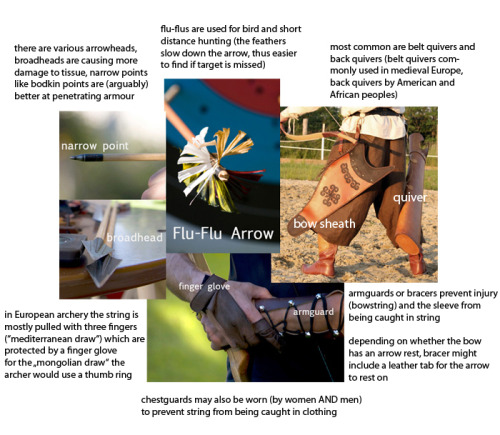
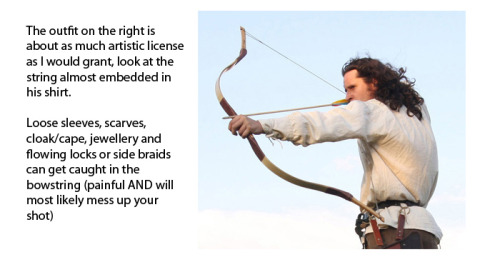
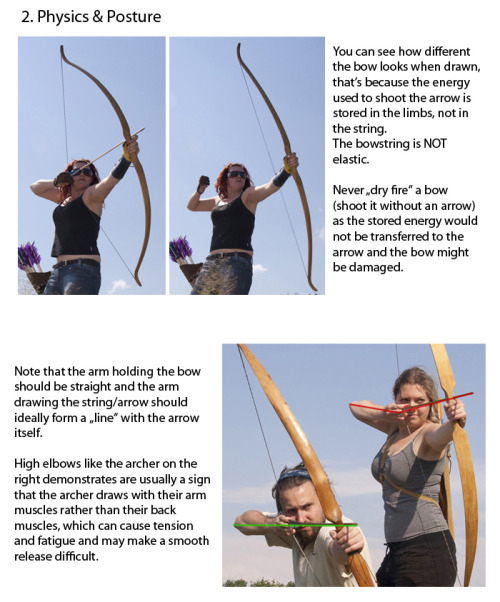

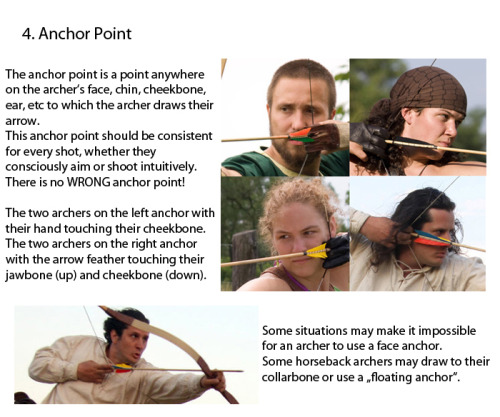
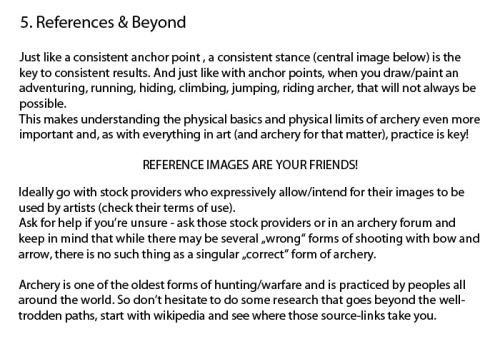

Spent the last two days working on this little archery guide in art and writing. Considering the rise in popularity of archers in pop culture this hopefully comes in handy for a bunch of fandoms.
Hello! How would you write a dialogue in which a character is freaking out about something? I generally have them word vomit but I don't really like that style. If its too much could you show me an example as well?
Hi!
You could definitely word vomit – especially if your character is hysterical – but that’s not the only way to do it by any means. I know a few other ways.
1. Calmly.This is strange, considering your character is freaking out, but the freak-out is internal – they’re shutting themselves off due to shock. In this case, they would be quiet, sane, and even if what they’re saying is illogical, it would probably sound reasonable.
“I was right there when she shot him. He dropped like a sack of flour. I figured he was gone as soon as the bullet hit his chest. So now I’ve decided I’m gonna go after her. Right now. And I’m gonna kill her.”“What? You can’t do that!”“Sure I can. She killed him, so I kill her. It’s called justice.”“But- With just your bare hands?”“The way I feel right now, my bare hands are more than enough.”
Notice how the character who just watched their friend die in front of them isn’t yelling, isn’t stuttering, isn’t getting angry or crying – they’re perfectly calm, almost to the point of complete emotional shutdown.
2. Angrily.Some people get angry when they lose control and freak out – it scares them, and the fear manifests itself as anger. This type particularly happens when they’re upset about something and other characters aren’t taking it seriously or are shrugging off their concerns.
“No! It’s happening tonight! We don’t have time to think, or weigh things, we need to fucking leave! Now!”“We can’t. You know that, and you’d remember that, if you were thinking straight-”“I am thinking straight! It’s you who’s fucked in the head. I don’t give a damn what you think we can and can’t do, we need to clear out of here, right this second.”
As you can see, this character is freaking out – their concerns may or may not have a firm foundation, but obviously they are concerned, and that concern is manifesting itself as fury.
3. By stuttering.For some people, it’s hard to talk when they panic, because their minds race forward ahead of their mouths and they get tongue-tied. I typically see/use this with more anxious characters, or with characters who aren’t typically good at speaking anyways (in other words, who are uncomfortable talking).
There are a couple of different ways to stutter:a. Repeat the beginning of each word.
“I tr-tried to s-save him, but he wuh-wouldn’t l-let me … he knew it was g-going to happen. It’s my f-fault!”
(However, keep in mind that this kind of stuttering is more as if your character is crying and trying to talk through sobs and hiccups. Please use it sparingly – it can get old fast.)
b. Repeat words.
“No. No, I don’t know what’s going on, Ricky. Ricky, why would I have any idea? Don’t fucking look at me like that, Ricky. Don’t look at me like I’m lying.”
c. Insert filler sounds: “ah”, “uh”, “um”, and/or curse words.
“I, uh, I- fuck. I, ummm, I think maybe, ah, maybe we should leave?”
For more on stuttering – it can be hard to peg correctly – check out this post.
I hope this helps! If you need anything else, please feel free to ask. - @authors-haven
-
 an-angels-fury liked this · 3 weeks ago
an-angels-fury liked this · 3 weeks ago -
 theveganwildflower reblogged this · 1 month ago
theveganwildflower reblogged this · 1 month ago -
 meridius-malfeasant reblogged this · 1 month ago
meridius-malfeasant reblogged this · 1 month ago -
 theveganwildflower reblogged this · 1 month ago
theveganwildflower reblogged this · 1 month ago -
 tormentum-ab-intra liked this · 1 month ago
tormentum-ab-intra liked this · 1 month ago -
 spuercrazycat16 liked this · 2 months ago
spuercrazycat16 liked this · 2 months ago -
 ruunkur reblogged this · 2 months ago
ruunkur reblogged this · 2 months ago -
 ihavemace reblogged this · 2 months ago
ihavemace reblogged this · 2 months ago -
 impossiblewizardtraveler-blog reblogged this · 2 months ago
impossiblewizardtraveler-blog reblogged this · 2 months ago -
 impossiblewizardtraveler-blog liked this · 2 months ago
impossiblewizardtraveler-blog liked this · 2 months ago -
 wedonttalkaboutrocco reblogged this · 2 months ago
wedonttalkaboutrocco reblogged this · 2 months ago -
 mad-mongoose-from-enormous-sea reblogged this · 2 months ago
mad-mongoose-from-enormous-sea reblogged this · 2 months ago -
 somethinginterestingtho reblogged this · 2 months ago
somethinginterestingtho reblogged this · 2 months ago -
 isbbc liked this · 2 months ago
isbbc liked this · 2 months ago -
 hxrrymybae reblogged this · 2 months ago
hxrrymybae reblogged this · 2 months ago -
 ajcoca3 liked this · 2 months ago
ajcoca3 liked this · 2 months ago -
 redpanda411 liked this · 2 months ago
redpanda411 liked this · 2 months ago -
 atlas-tries reblogged this · 2 months ago
atlas-tries reblogged this · 2 months ago -
 1ebilcat reblogged this · 2 months ago
1ebilcat reblogged this · 2 months ago -
 rileylapidot liked this · 2 months ago
rileylapidot liked this · 2 months ago -
 nicejupiter reblogged this · 2 months ago
nicejupiter reblogged this · 2 months ago -
 nicejupiter liked this · 2 months ago
nicejupiter liked this · 2 months ago -
 inconstantsearchofperfection reblogged this · 2 months ago
inconstantsearchofperfection reblogged this · 2 months ago -
 geeseoul reblogged this · 2 months ago
geeseoul reblogged this · 2 months ago -
 tomkitt liked this · 2 months ago
tomkitt liked this · 2 months ago -
 roguemortal reblogged this · 2 months ago
roguemortal reblogged this · 2 months ago -
 whatareyoureallyafraidof reblogged this · 2 months ago
whatareyoureallyafraidof reblogged this · 2 months ago -
 bittersweetsparadise reblogged this · 2 months ago
bittersweetsparadise reblogged this · 2 months ago -
 bittersweetsparadise liked this · 2 months ago
bittersweetsparadise liked this · 2 months ago -
 bromeliadgoingdragon liked this · 2 months ago
bromeliadgoingdragon liked this · 2 months ago -
 xx-j4c0-j4wbr34k3r-xx liked this · 2 months ago
xx-j4c0-j4wbr34k3r-xx liked this · 2 months ago -
 dronegutz liked this · 3 months ago
dronegutz liked this · 3 months ago -
 inkandpaintsnowleopard reblogged this · 3 months ago
inkandpaintsnowleopard reblogged this · 3 months ago -
 inkandpaintsnowleopard liked this · 3 months ago
inkandpaintsnowleopard liked this · 3 months ago -
 seieiankoku liked this · 3 months ago
seieiankoku liked this · 3 months ago -
 fredref reblogged this · 3 months ago
fredref reblogged this · 3 months ago -
 princesscrystal-hyperfixations liked this · 4 months ago
princesscrystal-hyperfixations liked this · 4 months ago -
 queza69 liked this · 4 months ago
queza69 liked this · 4 months ago -
 squeackygee reblogged this · 4 months ago
squeackygee reblogged this · 4 months ago -
 alex-issad liked this · 4 months ago
alex-issad liked this · 4 months ago -
 polkadotjellyfish reblogged this · 5 months ago
polkadotjellyfish reblogged this · 5 months ago -
 eridineon reblogged this · 5 months ago
eridineon reblogged this · 5 months ago -
 d-niceone liked this · 5 months ago
d-niceone liked this · 5 months ago -
 sapient-simian liked this · 5 months ago
sapient-simian liked this · 5 months ago -
 hanntayl0r reblogged this · 5 months ago
hanntayl0r reblogged this · 5 months ago
Right now this is just anything that comes to mind since I'm a complete noob at tumblr. I've been hearing about it for years but I never really felt like I had anything to say. Well all that has changed now and I figured I'd see what all the hype about tumlr is really about. Anyway don't take anything I say too seriously for now...I'll probably change it later when I become more comfortable with this website.
168 posts